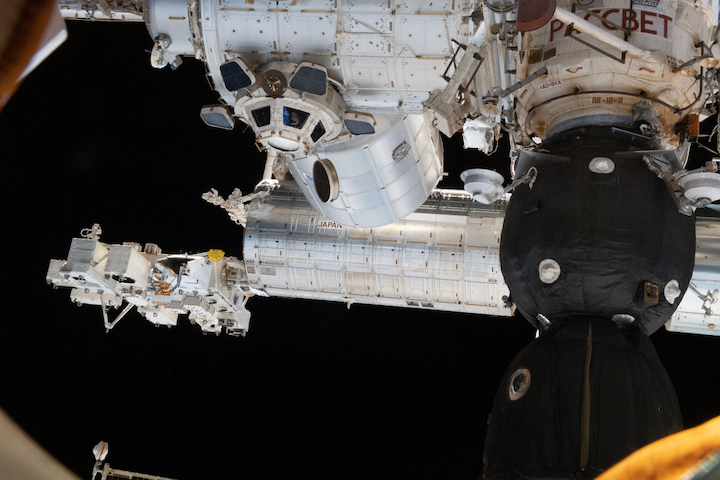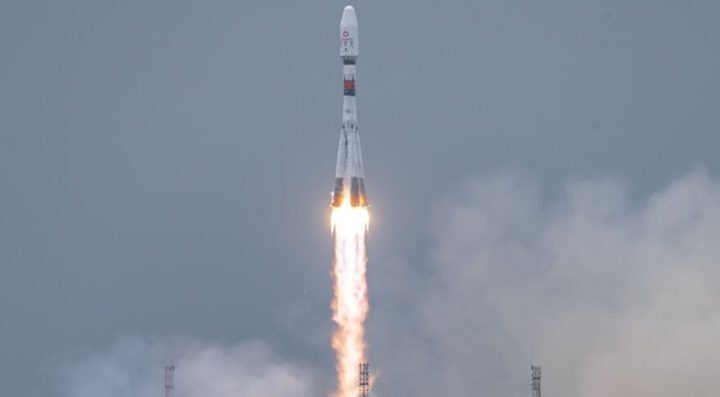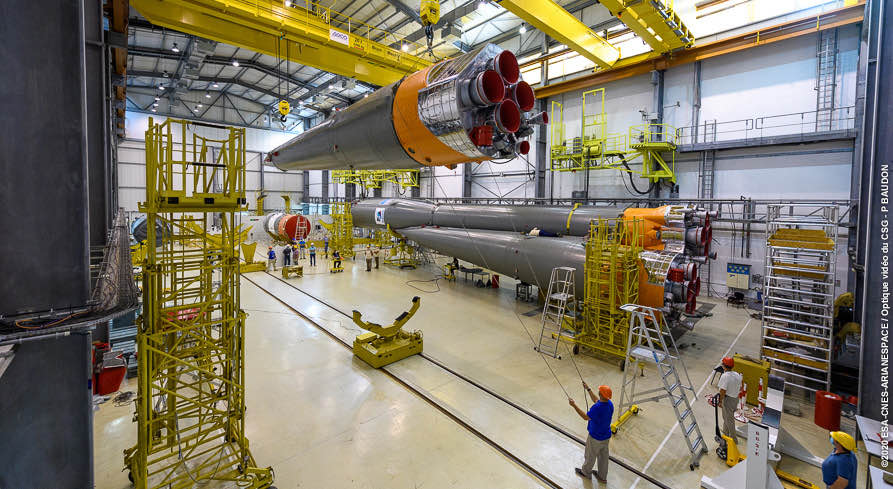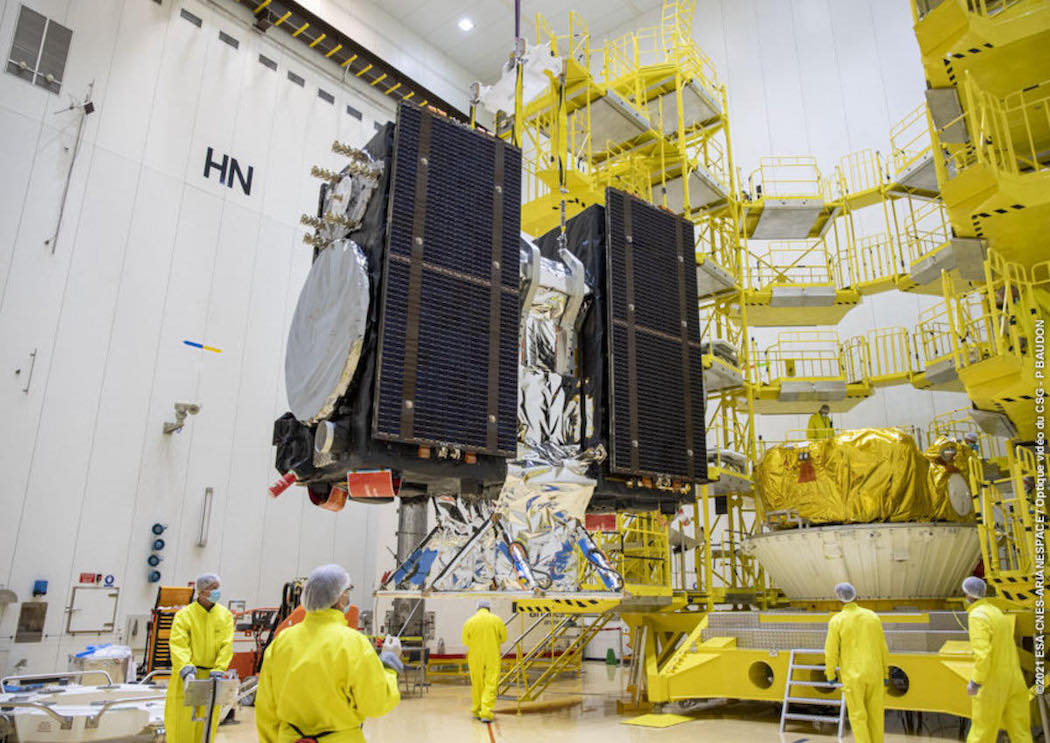26.02.2022

SAN FRANCISCO – While Russia’s invasion of Ukraine could have important space policy ramifications for the United States, the impact is not likely to be as significant as shifts that have already occurred in the wake Russia’s 2014 annexation of Crimea.
“What we’ve seen over the intervening eight years is a greater separation of Russia and the West in space,” Jeff Foust, senior SpaceNews staff writer, said Feb. 25 during a webinar from Duke University’s Space Diplomacy Lab. “Russia appears to be moving closer to China” with talks focused on an international lunar research station pegged for the 2030s and potential space station cooperation.
And while Russia continues to conduct more orbital launches than any nation besides China and the United States, it has lost its once enviable share of the commercial launch market to competition from SpaceX and others.
The United States and Russia remain partners through the International Space Station, which maintains its orbit thanks to periodic boosts from Russian vehicles and derives power from U.S. solar panels. In spite of economic sanctions being levied in response to Russia’s invasion of Ukraine and anger expressed on Twitter by Dmitry Rogozin, Roscosmos director general, Russia is not likely to pull out of the ISS program.
“There is reason for [Russia] to stay and grumble and complain, but still not put all their cards in the China deck,” said W. Robert Pearson, former U.S. ambassador to Turkey and Duke University Diplomacy Program fellow. “There’s a standard for Russia to keep one chair at another desk and that could be the space station.”
“If Russia decided to terminate its participation in ISS in 2024, there really wouldn’t be much for its human spaceflight program to do,” Foust said.
Russia has continued to invest in ISS upgrades. Last year, Russian cosmonauts attached a new Russian module. And while Russia is developing its own space station, its launch remains years away.
If Russia were to walk away from ISS, the country’s human spaceflight program would have few options other than to “fly some Soyuz [capsules] around in orbit for a few days at a time,” Foust said. “I don’t think that’s particularly palatable to them.”
Prior to Russia’s 2014 annexation of Crimea, U.S. and Russian space programs were tightly coupled. In response to sanctions, Rogozin, then Russian deputy prime minister, threatened to deny NASA access to seats on the Soyuz capsule and halt export of RD-180 rocket engines.
While neither action was ultimately taken, the comments had serious repercussions for U.S. space policy.
At the time, Soyuz was NASA’s only means of transporting astronauts to ISS, while the space agency was seeking congressional funding for its campaign to encourage U.S. companies to develop vehicles to provide crew transportation.
“The threat of losing access to Soyuz seats wiped away the last of the skepticism on Capitol Hill about the Commercial Crew Program,” Foust said. After 2014, Congress gave NASA the funding the agency requested for the Commercial Crew Program, whereas in previous years Congress supplied only a fraction of the funding requested. NASA now relies on SpaceX’s Crew Dragon vehicle to ferry astronauts to and from the ISS and expects to have a second U.S. option once Boeing’s Starliner CST-100 vehicle is ready to carry people.
Similarly, while RD-180 engine exports continued, the United States launch sector and United Launch Alliance began looking for alternative propulsion. Rogozin threatened to cut off RD-180 exports around the same time that SpaceX CEO Elon Musk was suing to force the U.S. Air Force to bring competition to national security launches rather than awarding contracts directly to ULA. Congress, meanwhile, took legislative action to curtail ULA’s use of RD-180 engines for national security launches.
“That combination of the threat of losing the RD-180 and SpaceX demanding the chance for competition led to changes in the program,” Foust said.
Now, both ULA and SpaceX conduct launches for the U.S. military. ULA is preparing to launch the new Vulcan rocket with a domestically produced engine.
Atlas 5 rockets continue to rely on RD-180 engines, but ULA has all the RD-180s it needs for its remaining Atlas launches. ULA CEO Tory Bruno said Feb. 25 that ULA and propulsion partner Aerojet Rocketdyne have enough RD-180 expertise in-house to keep Atlas 5 flying without access to Energomash, the Russian company that built the engines under the RD-Amross joint venture with the former Pratt & Whitney Rocketdyne.
“Been flying them for many years, lots of experience,” Bruno said via Twitter. “Also, I have personal experience in flying other people’s rockets without their support, which informs my confidence.”
Quelle: SN
+++
ULA: Russia sanctions not expected to disrupt Atlas 5 operations
WASHINGTON — The Russian rocket engines that United Launch Alliance needs to complete the remaining launches of the Atlas 5 are stored in the United States. The company said the operation of the vehicle will not be affected by the economic sanctions imposed on Russia by the Biden administration in response to Russia’s invasion of Ukraine.
“As we manage the transition to the Vulcan launch system, all necessary RD-180 engines to execute the Atlas 5 fly-out are safely stored in our factory in Decatur, Alabama,” ULA spokesperson Jessica Rye said in a statement.
The Russian-made RD-180 rocket engine powers the first stage of the Atlas 5 launch vehicle. Following Russia’s 2014 invasion of Crimea, Congress directed the Pentagon to stop using launch vehicles powered by Russian engines and only allowed DoD to award contracts for Atlas 5 launches through 2022.
ULA is transitioning to Vulcan Centaur — a new launch vehicle that will use the Blue Origin BE-4 engine made in the United States — but has contracts to launch about 25 more missions for government and commercial customers on the Atlas 5 between now and 2025.
It’s still unclear if the latest sanctions announced by the Biden administration will restrict ULA from buying spare parts or obtaining technical support services from the RD-180 manufacturer NPO Energomash. “We have agreements for technical support and spares, but if that support is not available, we will still be able to safely and successfully fly out our Atlas program,” said Rye.
ULA’s CEO Tory Bruno said the company has been flying these engines for many years and is not dependent on Energomash for technical expertise. “I have personal experience in flying other people’s rockets without their support, which informs my confidence,” Bruno tweeted Feb. 25. “We like to have a retainer in order to ask questions or do repairs if that were to come up. But we have a lot of experience and expertise here, so we can do without if necessary.”
The RD-180 was put on Atlas “because the U.S. government asked us to,” Bruno noted. “They wanted to prevent Russian rocket scientists from going to North Korea and Iran after the Cold War. After Crimea in 2014, the U.S. government decided this was no longer a good idea. I came to ULA that summer and started Vulcan.”
ULA on Feb. 15 announced an agreement with Milling Precision in Wichita, Kansas, to supply components for the Atlas 5 rocket.
“We will continue to cultivate new supplier relationships to ensure we safely and successfully fly out the program,” Rye said.
Quelle: SN
----
Update: 27.02.2022
.
Russia halts Soyuz launches from French Guiana

WASHINGTON — Roscosmos announced Feb. 26 that it is halting cooperation with Europe on Soyuz launches from French Guiana and withdrawing its personnel from the launch site in response to European sanctions for Russia’s invasion of Ukraine.
“In response to EU sanctions against our enterprises, Roscosmos is suspending cooperation with European partners in organizing space launches” from French Guiana, Roscosmos said in a pair of tweets, citing a statement by its head, Dmitry Rogozin. The agency said it will withdraw the 87 employees of several Russian companies that support Soyuz launches there, although the details of that withdrawal are “being worked out.”
The announcement will, at a minimum, delay a Soyuz launch of two Galileo navigation satellites that had been scheduled for April from French Guiana, with another pair of Galileo satellites scheduled to launch later in the year on another Soyuz. The European Space Agency planned to launch its EarthCARE Earth science mission, developed in cooperation with the Japanese space agency JAXA, on a Soyuz in 2023, along with the Euclid infrared space telescope. The French government was also expected to launch its CSO-3 reconnaissance satellite on a Soyuz in early 2023.
An ESA spokesperson told SpaceNews Feb. 26 that the agency had no immediate comment on the Roscosmos announcement. An “internal crisis coordination meeting” is scheduled for Feb. 28, after which ESA may issue a statement. Arianespace, which offers the Soyuz for commercial launches from French Guiana and other spaceports, did not immediately respond to a request for comment.
Thierry Breton, the European Union commissioner whose portfolio includes space, said in a Feb. 26 statement that the decision has no immediate effects on the “continuity and quality” of the Galileo system or on the Copernicus series of Earth science spacecraft. “We will take all relevant decisions in response to this decision in due course and continue developing resolutely the second generation of these two E.U. sovereign space infrastructures,” he said.
The decision to suspend Soyuz launches from French Guiana is one of the few levers on space-related issues that Russia can pull to react to Western sanctions without jeopardizing its own space capabilities, such as operations of the International Space Station. Western dependence on Russian space systems and technologies has declined significantly since Russia’s 2014 annexation of Crimea, when Russia threatened to cut off access to seats on Soyuz spacecraft flying to the ISS and halt exports of the RD-180 engines used on the Atlas 5 in response to U.S. sanctions.
Future use of the French Guiana launch site by Soyuz rockets was in question even before the Roscosmos announcement. In January, Stéphane Israël, chief executive of Arianespace, said he expected European institutional customers that had been using Soyuz to move to the Vega C and Ariane 6 vehicles, slated to make their first launches later this year.
“We’ve had discussions with our Russian partners to see whether there is a business case to go beyond 2023 or not,” he said then, suggesting at the time that ESA support for continued Soyuz launches be discussed at the November ESA ministerial meeting. “It could be that maintaining a capability as a backup for Ariane 6 and Vega C could be part of the business case.”
Roscosmos also announced via a tweet that Rogozin concluded that it was “inappropriate” for the U.S. to continue cooperation with Russia on the proposed Venera-D mission to Venus. That move is largely a ceremonial one because, while there have been discussions between American and Russian scientists on a potential role for NASA on Venera-D, the mission itself has suffered extensive delays and is unlikely to launch before the end of the decade, if at all.
Quelle: SN
+++
Russia suspends Soyuz launch operations in French Guiana
Blaming European sanctions enacted after Russia’s invasion of Ukraine, the Russian space agency said Saturday it is recalling dozens of engineers and technicians from French Guiana and suspending Soyuz rocket operations there, grounding a pair of European navigation satellites previously set for launch in early April.
The decision, announced by Russian space agency chief Dmitry Rogozin, also brings into question the long-term future of the Soyuz launch base at the Guiana Space Center, a European-run spaceport on the northeastern coast of South America.
Russian teams were preparing a Soyuz rocket and Fregat upper stage for launch April 5 from the spaceport near Kourou, French Guiana, with two European Galileo navigation satellites. The two European satellites and their Russian launch vehicle have already been delivered to the space center, but the preparations require expertise from Russian crews.
“In response to EU sanctions against our enterprises, Roscosmos is suspending cooperation with European partners in organizing space launches from the Kourou cosmodrome and withdrawing its technical personnel, including the consolidated launch crew, from French Guiana,” Rogozin tweeted Saturday.
The Soyuz launch base in French Guiana entered service in 2011 under the auspices of a cooperative agreement between Roscosmos and the European Space Agency. Since then, 27 Soyuz rockets have launched from the Guiana Space Center, carrying Galileo navigation satellites, commercial communications and Earth observation payloads, space science missions, and French and Italian military satellites.
French Guiana is an overseas department of France, meaning the spaceport is built on the territory of a NATO country. The Soyuz launch pad in French Guiana is European-owned, and the French launch service provider Arianespace oversees launch operations at the site.
It took three years and cost European governments $800 million to develop the Soyuz launch capability in French Guiana.
The European Union announced new sanctions this week against Russia, targeting Russian businesses and defense enterprises after Russia’s military invaded Ukraine. On Friday, the EU said it would freeze any European assets of Russian President Vladimir Putin.
Roscosmos said there are 87 Russian citizens currently in French Guiana preparing for the planned Soyuz launch in April. They are employees of NPO Lavochkin, which manufactures the Fregat upper stage, and the Progress Rocket Space Center, builder of Russia’s Soyuz rocket. There are also staff at the Guiana Space Center from TsENKI, a Russian company that provides ground infrastructure and support services for space missions.
“The issue of the departure of Russian employees is being worked out,” Roscosmos said.

“I confirm that this decision has no consequences on the continuity and quality of the Galileo and Copernicus services,” said Thierry Breton, European commissioner for space, referring to Europe’s Copernicus fleet of environmental monitoring satellites. “Nor does this decision put the continued development of these infrastructures at risk.
“We will take all relevant decisions in response to this decision in due course and continue developing resolutely the second generation of these two EU sovereign space infrastructures,” Breton said in a statement.
“We are ready to act decisively, together with the member states, to protect these critical infrastructures in case of aggression, and continue to develop Ariane 6 and Vega C to ensure Europe’s strategic autonomy in the area of launchers.”
After the April launch, another Soyuz rocket was scheduled to take off from French Guiana later this year with two additional Galileo navigation satellites. The Galileo network is Europe’s independent space-based global navigation system, an analog to the U.S. military’s GPS fleet, Russia’s Glonass system, and China’s Beidou navigation constellation.
Galileo satellites are already beaming navigation signals to users around the world. More than 2 billion smartphones have been sold with Galileo-enabled chipsets, allowing users to locate themselves with navigation signals from Galileo satellites alongside data from GPS network.
The most recent launch for the Galileo system in December deployed the 27th and 28th operational Galileo satellites on a Soyuz rocket. The Galileo program is a multibillion-dollar initiative managed by the European Commission, the executive body of the European Union, a separate entity from ESA.
The full Galileo constellation needs 30 satellites, including 24 active platforms and six spares. The launches later this year with Soyuz rockets were planned to complete the full deployment of the network, but that timetable is in doubt with Soyuz operations suspended.
After this year, future Galileo satellites are planned to launch on European Ariane 6 rockets to upgrade the system and replace old spacecraft. The Ariane 6 rocket’s debut has been delayed, and its first launch is scheduled for no earlier than the end of 2022. Once Ariane 6 is flying, ESA and
When fully operational, the Galileo network will provide independent navigation fixes for users without needing GPS signals. With both networks available, combining Galileo and GPS data can give users a more precise position estimate.
Other missions booked to launch on Soyuz rockets from French Guiana include the French military’s CSO 3 optical spy satellite and the EarthCARE climate science mission for the European Space Agency.
ESA’s Euclid telescope, designed to study dark energy and dark matter, is also assigned to a Soyuz launch from French Guiana next year.
Arianespace and ESA did not respond to questions on the future of Soyuz launches in French Guiana, but ESA issued a statement Friday — before Roscosmos said it was suspending Soyuz operations at the Guiana Space Center — saying it was assessing “possible consequences for ESA’s ongoing activities” caused by Russia’s invasion of Ukraine.

“ESA is committed to continuing the work of all its program activities, including the ongoing ExoMars launch campaign, to ensure their successful implementation, wherever possible,” the agency said.
The ExoMars mission is a joint program between ESA and Roscosmos. The first element the ExoMars mission was a European-built science orbiter launched to Mars in 2016 by a Russian Proton rocket.
The next piece of ExoMars is a European rover designed to be delivered to the surface of the Red Planet next year by a Russian-built entry vehicle and lander. The ExoMars rover is scheduled to launch in September on another Russian Proton rocket.
The mission architecture requires close cooperation between Russia and Europe, with Russia responsible for the launch and landing. ESA’s rover carries most of the scientific instrumentation, including payloads supplied by NASA.
NASA said Thursday that new U.S. sanctions against Russia announced by President Biden will not have any immediate effects on the International Space Station, another program that requires close international cooperation between Western nations and Russia.
Rogozin, the head of Russia’s space agency, also said Saturday that Roscosmos will stop cooperation with NASA on the Venera-D project, a planned robotic exploration mission to Venus. He said continuing with the partnership would be “inappropriate.”
Arianespace also manages commercial Soyuz rocket launches from the Baikonur Cosmodrome in Kazakhstan and the Vostochny Cosmodrome in Russia. The next of those missions is set for takeoff from Kazakhstan on March 4 with 36 more satellites for OneWeb’s global internet network, and officials have announced any delay for that launch.
Quelle: SN
